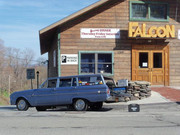With the final overdrive gear ratio of .78 it would be at 2400 rpm at 75 mph. I feel like that is a bit better of an improvement
You are using an out of date browser. It may not display this or other websites correctly.
You should upgrade or use an alternative browser.
You should upgrade or use an alternative browser.
All Small Six C4 Gear Vendor overdrive
- Thread starter beanmiester
- Start date
This relates to all small sixes
Rod Beauvex
Active member
Here is one of those calculators mentioned earlier. You will need to know your tire diameter though.

 spicerparts.com
spicerparts.com

Spicer Transmission Ratio RPM Calculator
Use the Spicer Transmission Ratio RPM Calculator to determine your engine’s RPM based on the transmission gear ratio, tire height, MPH, and ring and pinion gear ratio.
 spicerparts.com
spicerparts.com
300 to 350 rpm difference at 75 mph? To me that doesn’t seem like much improvement for the cost in parts and labor. If it was 800 to 1000, that might be a different story.With the final overdrive gear ratio of .78 it would be at 2400 rpm at 75 mph. I feel like that is a bit better of an improvement
This is one reason I will be going with a 8in rear axel- gear options.
I was going to change the rearend too but I don't quite know to what. Mist of the recommendations I see are for performance cars not little puttering around cars300 to 350 rpm difference at 75 mph? To me that doesn’t seem like much improvement for the cost in parts and labor. If it was 800 to 1000, that might be a different story.
This is one reason I will be going with a 8in rear axel- gear options.
Last edited:
What I got with the Spicer calculator is, RPM 6,800, tire 33'' gear ratio 4.86 = 137.42 .
That is also what I saw on tach and E.T. slip.
That is also what I saw on tach and E.T. slip.
Oh actually I just looked at it. Its like a 600 rpm difference. Sock its at 3100. With the final overdrive its 2419300 to 350 rpm difference at 75 mph? To me that doesn’t seem like much improvement for the cost in parts and labor. If it was 800 to 1000, that might be a different story.
This is one reason I will be going with a 8in rear axel- gear options.
Yeah they are. I just realized that might have been confusing. Sorry 
What is the need for driving so dangerously fast? Slowing down will lower the rpm into a sane region, and recreate the chance of surviving a crash. ??2742 still too high?
Interstate. They pull you off if you go 6 mph below the speed limit near downtown Tucson. Which i have to pass by if im to go anywhere in a timely manner. Its 75 mph there now. I got my car to stop very well so if I keep good following distance I should be fine
My 66 Mustang 200 with T5 is similar. My tach is pretty tiny so it’s hard to differentiate between 2000 and 2100 RPM but here’s my readings.
5th Gear:
1800-1900 RPM = 60 MPH
2000-2100 RPM = 70 MPH
2200-2300 RPM = 80 MPH.
I’ve taken it to 90 MPH and it was more than happy to keep going.
It’ll do 70 MPH all day long. It’ll do 80 MPH too but is pretty noisy (wind noise, road noise, engine). I need some sound deadening and hopefully it’ll be better. The car is absolutely happy at those speeds.
Since this is a classic. I would lean towards a complete rearend changeout. The less the car is modified, the more it would be worth down the road.
There were 2:83’s for the Mustang six in 1966:

This one was found on car-part.com
This would be the simplest, most reliable and cheapest way to go.
The C4 is more than capable to handle the ratio changeout.
A larger transmission oil cooler can always be added any time. If a larger transmission oil cooler is installed. The best way to hook it up is:
Install the cooler outlet line to larger oil cooler inlet line first. Than install the larger oil cooler outlet line to the radiator oil cooler inlet. This way the oil temperature will be roost to radiator coolant temperature. Having transmission fluid too cool is not good.
There were 2:83’s for the Mustang six in 1966:

This one was found on car-part.com
This would be the simplest, most reliable and cheapest way to go.
The C4 is more than capable to handle the ratio changeout.
A larger transmission oil cooler can always be added any time. If a larger transmission oil cooler is installed. The best way to hook it up is:
Install the cooler outlet line to larger oil cooler inlet line first. Than install the larger oil cooler outlet line to the radiator oil cooler inlet. This way the oil temperature will be roost to radiator coolant temperature. Having transmission fluid too cool is not good.
If i didn't care about resale value and just pure drivability and gas mileage would the gv addition be worth it?
Im going to check out the rearend too
Im going to check out the rearend too
rickwrench
Famous Member
You may see a bit of an MPG improvement with overdrive as you're cruising right around the torque peak, and your engine will happier, long term, running at a lower rpm. But MPG is much more dependent upon speed/drag. It takes a certain amount of horsepower to overcome drag, which increases pretty steeply the faster you go. Simple enough to calculate what mpg you should be getting @60, 65, 70, etc. mph.
I figured. I never did actually calculate it but i figured it would be lower even if its just a little bit. Im more concerned about the rpm. We'll see if I decide to swap the rearend or go with the GV.
Kinetic energy = 1/2 MV squared. The effect of increasing speed is far more energy-intensive than our human logic casually assumes.I figured. I never did actually calculate it but i figured it would be lower even if its just a little bit. Im more concerned about the rpm. We'll see if I decide to swap the rearend or go with the GV.
Doubling speed quadruples the energy stored in the vehicle. And every variable associated with it. Wind drag being the primary factor in why slower is more efficient. Engine RPM is very much of a secondary factor. More engine power is required to move faster, regardless of RPM.
There is 2X more drag at 70 mph from 50 mph.
(Just for kicks-) Taking 45 mph as a base-line, the drag increase as speed increases is:
45mph to 50 mph = 23% more inertia/wind drag
45mph to 55 mph = 49% more inertia/wind drag
45mph to 60 mph = 78% more inertia/wind drag
45mph to 65 mph = 209% more inertia/wind drag.
45mph to 70 mph = 242% more inertia/wind drag.
Stopping distance and impact inertia force go up by the same percentages. . . Slower is better in every category, including getting home undamaged and uninjured. . Regardless of how much gas is left in the tank.
Kinetic energy = 1/2 MV squared. The effect of increasing speed is far more energy-intensive than our human logic casually assumes.
Doubling speed quadruples the energy stored in the vehicle. And every variable associated with it. Wind drag being the primary factor in why slower is more efficient. Engine RPM is very much of a secondary factor. More engine power is required to move faster, regardless of RPM.
There is 2X more drag at 70 mph from 50 mph.
(Just for kicks-) Taking 45 mph as a base-line, the drag increase as speed increases is:
45mph to 50 mph = 23% more inertia/wind drag
45mph to 55 mph = 49% more inertia/wind drag
45mph to 60 mph = 78% more inertia/wind drag
45mph to 65 mph = 209% more inertia/wind drag.
45mph to 70 mph = 242% more inertia/wind drag.
Stopping distance and impact inertia force go up by the same percentages. . . Slower is better in every category, including getting home undamaged and uninjured. . Regardless of how much gas is left in the tank.
That’s timely and interesting info for me. I’ve been commenting how notable wind noise is on my car between speeds.
Before I put the 5-speed in my Mustang, I had no interest in taking it on the highway because it just wasn’t suitable for dealing with congested, erratic traffic but now that it’s better equipped to get up to speed quickly, I’ve got no qualms about taking it out. The other day I was tooling along at about 60 MPH in 5th with engine speed at about 1800 RPM and this seemed to be my car’s happy place. Not a lot of road noise; not a lot of engine noise and not a lot of wind noise. Then I bumped up to about 70 MPH and now I’m at about 2000 RPM. The car was happy at that speed but the road noise had increased noticeably (no blanket on the firewall). The most noticeable thing though was the wind noise; the increase was really noticeable. Again, I think it was enhanced by the interior of the car. It’s got so much painted metal, rather than upholstery that sound just bounces around in it. I need to spend some time doing noise reduction on it.
My daily driver isn’t new. It’s a 20 year old Mercedes coupe but like all of the new cars today, it’s shaped like an egg. You can really tell how aerodynamic it is by the lack of wind noise it exhibits at speed compared to the Mustang. I also find the upright windshield in the Mustang has less glare at night compared to the long slanted windshield on the Mercedes.
An anecdote I read on one of the Mustang forums was about how they wind tunnel tested a fastback Mustang and to their dismay, how much more aerodynamic it was pointed backwards compared to when it was pointed forwards

Similar threads
All Small Six
1966 200ci in Mustang, General advice needed
- Replies
- 6
- Views
- 786
- Replies
- 4
- Views
- 703
All Small Six
I have a few questions about the 250ci
- Replies
- 8
- Views
- 1K
- Replies
- 8
- Views
- 3K
All Small Six
62 170/2speed to 65 200/c4 3speed swap issues.
- Replies
- 1
- Views
- 2K


